Huang
Qiao
Score-Informed BiLSTM Correction for Refining MIDI Velocity in Automatic Piano Transcription
Aug 11, 2025Abstract:MIDI is a modern standard for storing music, recording how musical notes are played. Many piano performances have corresponding MIDI scores available online. Some of these are created by the original performer, recording on an electric piano alongside the audio, while others are through manual transcription. In recent years, automatic music transcription (AMT) has rapidly advanced, enabling machines to transcribe MIDI from audio. However, these transcriptions often require further correction. Assuming a perfect timing correction, we focus on the loudness correction in terms of MIDI velocity (a parameter in MIDI for loudness control). This task can be approached through score-informed MIDI velocity estimation, which has undergone several developments. While previous approaches introduced specifically built models to re-estimate MIDI velocity, thereby replacing AMT estimates, we propose a BiLSTM correction module to refine AMT-estimated velocity. Although we did not reach state-of-the-art performance, we validated our method on the well-known AMT system, the high-resolution piano transcription (HPT), and achieved significant improvements.
A Quantitative Evaluation of the Expressivity of BMI, Pose and Gender in Body Embeddings for Recognition and Identification
Mar 09, 2025Abstract:Person Re-identification (ReID) systems identify individuals across images or video frames and play a critical role in various real-world applications. However, many ReID methods are influenced by sensitive attributes such as gender, pose, and body mass index (BMI), which vary in uncontrolled environments, leading to biases and reduced generalization. To address this, we extend the concept of expressivity to the body recognition domain to better understand how ReID models encode these attributes. Expressivity, defined as the mutual information between feature vector representations and specific attributes, is computed using a secondary neural network that takes feature and attribute vectors as inputs. This provides a quantitative framework for analyzing the extent to which sensitive attributes are embedded in the model's representations. We apply expressivity analysis to SemReID, a state-of-the-art self-supervised ReID model, and find that BMI consistently exhibits the highest expressivity scores in the model's final layers, underscoring its dominant role in feature encoding. In the final attention layer of the trained network, the expressivity order for body attributes is BMI > Pitch > Yaw > Gender, highlighting their relative importance in learned representations. Additionally, expressivity values evolve progressively across network layers and training epochs, reflecting a dynamic encoding of attributes during feature extraction. These insights emphasize the influence of body-related attributes on ReID models and provide a systematic methodology for identifying and mitigating attribute-driven biases. By leveraging expressivity analysis, we offer valuable tools to enhance the fairness, robustness, and generalization of ReID systems in diverse real-world settings.
Deriving Representative Structure from Music Corpora
Feb 21, 2025Abstract:Western music is an innately hierarchical system of interacting levels of structure, from fine-grained melody to high-level form. In order to analyze music compositions holistically and at multiple granularities, we propose a unified, hierarchical meta-representation of musical structure called the structural temporal graph (STG). For a single piece, the STG is a data structure that defines a hierarchy of progressively finer structural musical features and the temporal relationships between them. We use the STG to enable a novel approach for deriving a representative structural summary of a music corpus, which we formalize as a dually NP-hard combinatorial optimization problem extending the Generalized Median Graph problem. Our approach first applies simulated annealing to develop a measure of structural distance between two music pieces rooted in graph isomorphism. Our approach then combines the formal guarantees of SMT solvers with nested simulated annealing over structural distances to produce a structurally sound, representative centroid STG for an entire corpus of STGs from individual pieces. To evaluate our approach, we conduct experiments verifying that structural distance accurately differentiates between music pieces, and that derived centroids accurately structurally characterize their corpora.
Pseudo Strong Labels from Frame-Level Predictions for Weakly Supervised Sound Event Detection
Jan 07, 2025Abstract:Weakly Supervised Sound Event Detection (WSSED), which relies on audio tags without precise onset and offset times, has become prevalent due to the scarcity of strongly labeled data that includes exact temporal boundaries for events. This study introduces Frame-level Pseudo Strong Labeling (FPSL) to overcome the lack of temporal information in WSSED by generating pseudo strong labels from frame-level predictions. This enhances temporal localization during training and addresses the limitations of clip-wise weak supervision. We validate our approach across three benchmark datasets (DCASE2017 Task 4, DCASE2018 Task 4, and UrbanSED) and demonstrate significant improvements in key metrics such as the Polyphonic Sound Detection Scores (PSDS), event-based F1 scores, and intersection-based F1 scores. For example, Convolutional Recurrent Neural Networks (CRNNs) trained with FPSL outperform baseline models by 4.9% in PSDS1 on DCASE2017, 7.6% on DCASE2018, and 1.8% on UrbanSED, confirming the effectiveness of our method in enhancing model performance.
Impact of Noisy Labels on Sound Event Detection: Deletion Errors Are More Detrimental Than Insertion Errors
Aug 27, 2024Abstract:This study explores the critical but underexamined impact of label noise on Sound Event Detection (SED), which requires both sound identification and precise temporal localization. We categorize label noise into deletion, insertion, substitution, and subjective types and systematically evaluate their effects on SED using synthetic and real-life datasets. Our analysis shows that deletion noise significantly degrades performance, while insertion noise is relatively benign. Moreover, loss functions effective against classification noise do not perform well for SED due to intra-class imbalance between foreground sound events and background sounds. We demonstrate that loss functions designed to address data imbalance in SED can effectively reduce the impact of noisy labels on system performance. For instance, halving the weight of background sounds in a synthetic dataset improved macro-F1 and micro-F1 scores by approximately $9\%$ with minimal Error Rate increase, with consistent results in real-life datasets. This research highlights the nuanced effects of noisy labels on SED systems and provides practical strategies to enhance model robustness, which are pivotal for both constructing new SED datasets and improving model performance, including efficient utilization of soft and crowdsourced labels.
Envisioning Possibilities and Challenges of AI for Personalized Cancer Care
Aug 19, 2024
Abstract:The use of Artificial Intelligence (AI) in healthcare, including in caring for cancer survivors, has gained significant interest. However, gaps remain in our understanding of how such AI systems can provide care, especially for ethnic and racial minority groups who continue to face care disparities. Through interviews with six cancer survivors, we identify critical gaps in current healthcare systems such as a lack of personalized care and insufficient cultural and linguistic accommodation. AI, when applied to care, was seen as a way to address these issues by enabling real-time, culturally aligned, and linguistically appropriate interactions. We also uncovered concerns about the implications of AI-driven personalization, such as data privacy, loss of human touch in caregiving, and the risk of echo chambers that limit exposure to diverse information. We conclude by discussing the trade-offs between AI-enhanced personalization and the need for structural changes in healthcare that go beyond technological solutions, leading us to argue that we should begin by asking, ``Why personalization?''
Field Testing of a Stochastic Planner for ASV Navigation Using Satellite Images
Sep 26, 2023



Abstract:We introduce a multi-sensor navigation system for autonomous surface vessels (ASV) intended for water-quality monitoring in freshwater lakes. Our mission planner uses satellite imagery as a prior map, formulating offline a mission-level policy for global navigation of the ASV and enabling autonomous online execution via local perception and local planning modules. A significant challenge is posed by the inconsistencies in traversability estimation between satellite images and real lakes, due to environmental effects such as wind, aquatic vegetation, shallow waters, and fluctuating water levels. Hence, we specifically modelled these traversability uncertainties as stochastic edges in a graph and optimized for a mission-level policy that minimizes the expected total travel distance. To execute the policy, we propose a modern local planner architecture that processes sensor inputs and plans paths to execute the high-level policy under uncertain traversability conditions. Our system was tested on three km-scale missions on a Northern Ontario lake, demonstrating that our GPS-, vision-, and sonar-enabled ASV system can effectively execute the mission-level policy and disambiguate the traversability of stochastic edges. Finally, we provide insights gained from practical field experience and offer several future directions to enhance the overall reliability of ASV navigation systems.
Masked Autoencoders that Listen
Jul 13, 2022
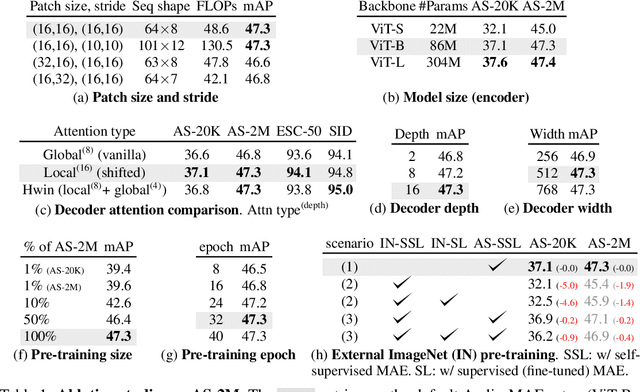

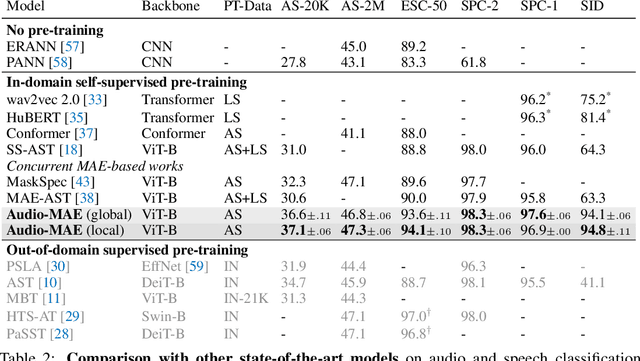
Abstract:This paper studies a simple extension of image-based Masked Autoencoders (MAE) to self-supervised representation learning from audio spectrograms. Following the Transformer encoder-decoder design in MAE, our Audio-MAE first encodes audio spectrogram patches with a high masking ratio, feeding only the non-masked tokens through encoder layers. The decoder then re-orders and decodes the encoded context padded with mask tokens, in order to reconstruct the input spectrogram. We find it beneficial to incorporate local window attention in the decoder, as audio spectrograms are highly correlated in local time and frequency bands. We then fine-tune the encoder with a lower masking ratio on target datasets. Empirically, Audio-MAE sets new state-of-the-art performance on six audio and speech classification tasks, outperforming other recent models that use external supervised pre-training. The code and models will be at https://github.com/facebookresearch/AudioMAE.
On Adversarial Robustness of Large-scale Audio Visual Learning
Mar 23, 2022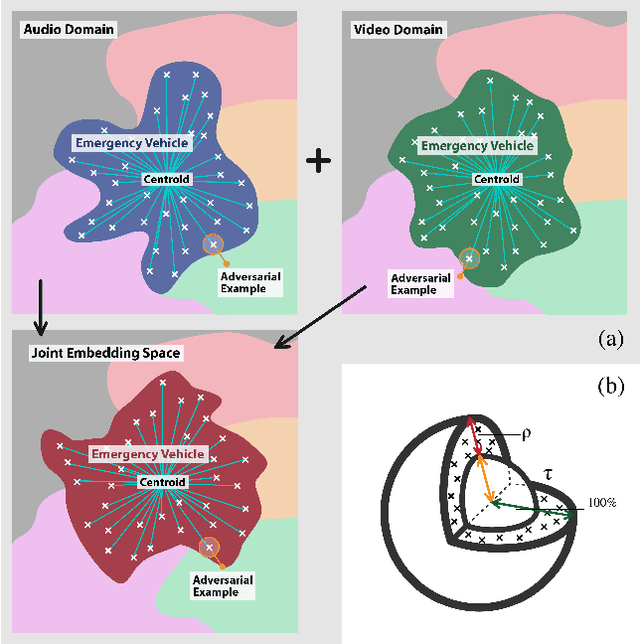
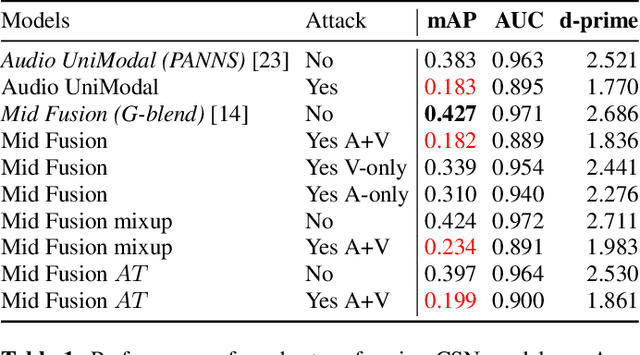
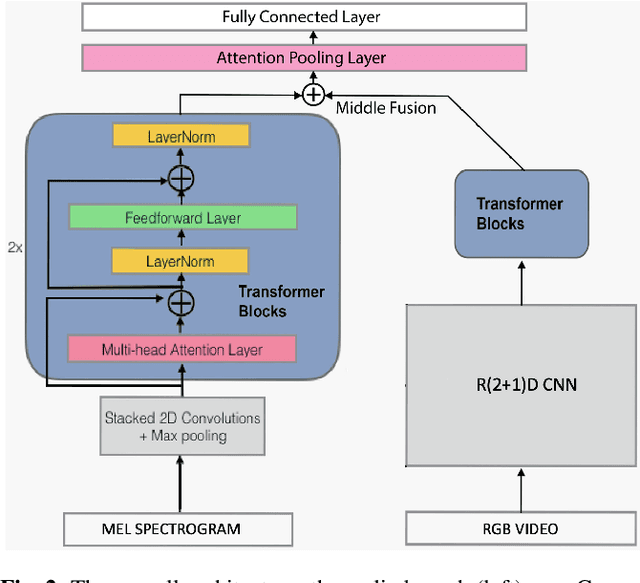
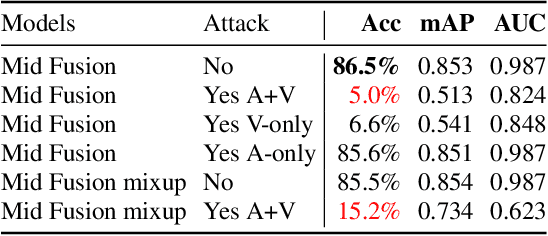
Abstract:As audio-visual systems are being deployed for safety-critical tasks such as surveillance and malicious content filtering, their robustness remains an under-studied area. Existing published work on robustness either does not scale to large-scale dataset, or does not deal with multiple modalities. This work aims to study several key questions related to multi-modal learning through the lens of robustness: 1) Are multi-modal models necessarily more robust than uni-modal models? 2) How to efficiently measure the robustness of multi-modal learning? 3) How to fuse different modalities to achieve a more robust multi-modal model? To understand the robustness of the multi-modal model in a large-scale setting, we propose a density-based metric, and a convexity metric to efficiently measure the distribution of each modality in high-dimensional latent space. Our work provides a theoretical intuition together with empirical evidence showing how multi-modal fusion affects adversarial robustness through these metrics. We further devise a mix-up strategy based on our metrics to improve the robustness of the trained model. Our experiments on AudioSet and Kinetics-Sounds verify our hypothesis that multi-modal models are not necessarily more robust than their uni-modal counterparts in the face of adversarial examples. We also observe our mix-up trained method could achieve as much protection as traditional adversarial training, offering a computationally cheap alternative. Implementation: https://github.com/lijuncheng16/AudioSetDoneRight
Design of EMG-driven Musculoskeletal Model for Volitional Control of a Robotic Ankle Prosthesis
Feb 17, 2022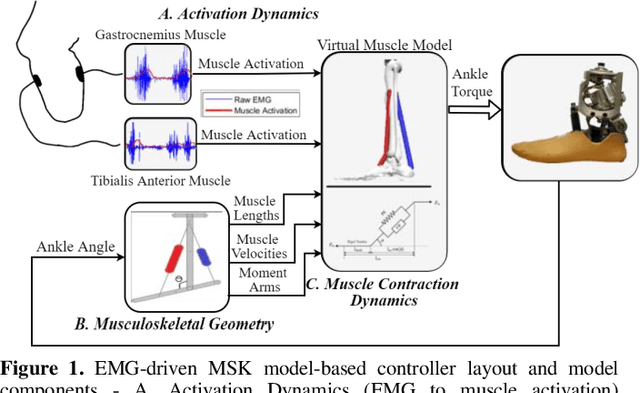
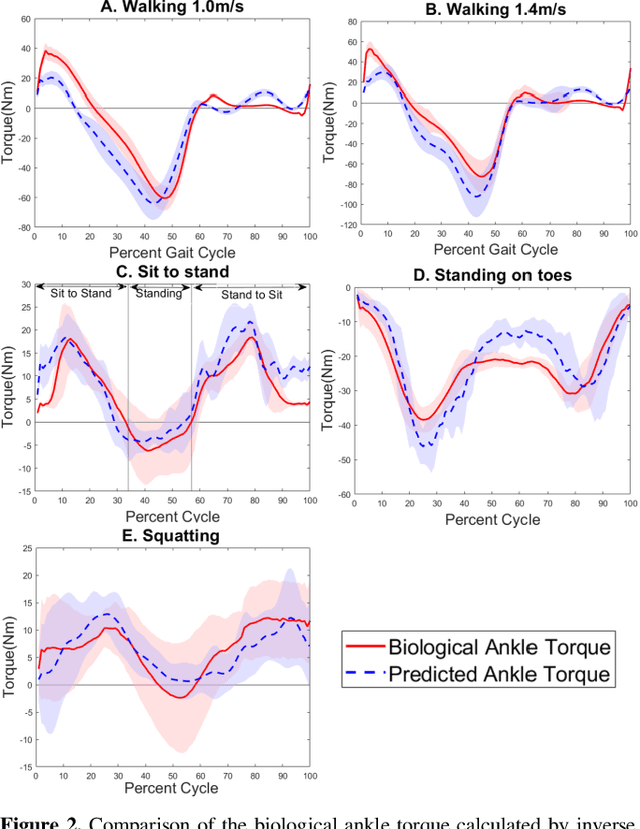
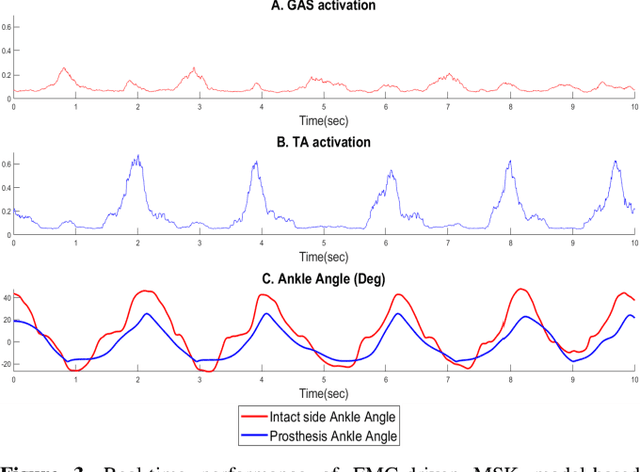
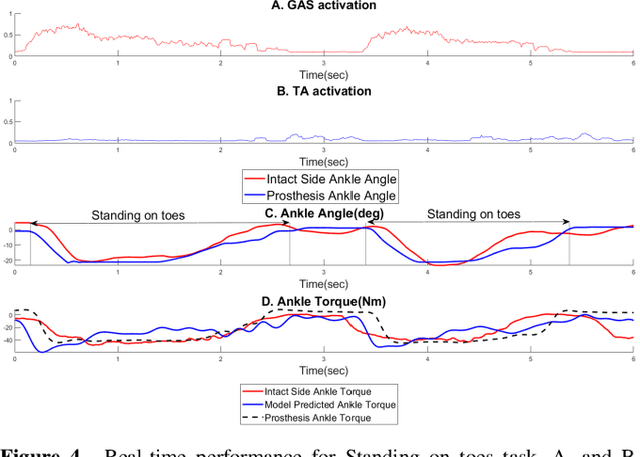
Abstract:Existing robotic lower-limb prostheses use autonomous control to address cyclic, locomotive tasks, but they are inadequate to operate the prosthesis for daily activities that are non-cyclic and unpredictable. To address this challenge, this study aims to design a novel electromyography (EMG)-driven musculoskeletal model for volitional control of a robotic ankle-foot prosthesis. This controller places the user in continuous control of the device, allowing them to freely manipulate the prosthesis behavior at will. The Hill-type muscle model was used to model a dorsiflexor and a plantarflexor, which functioned around a virtual ankle joint. The model parameters were determined by fitting the model prediction to the experimental data collected from an able-bodied subject. EMG signals recorded from ankle agonist and antagonist muscle pair were used to activate the virtual muscle models. This model was validated via offline simulations and real-time prosthesis control. Additionally, the feasibility of the proposed prosthesis control on assisting the user's functional tasks was demonstrated. The present control may further improve the function of robotic prosthesis for supporting versatile activities in individuals with lower-limb amputations.
 Add to Chrome
Add to Chrome Add to Firefox
Add to Firefox Add to Edge
Add to Edge